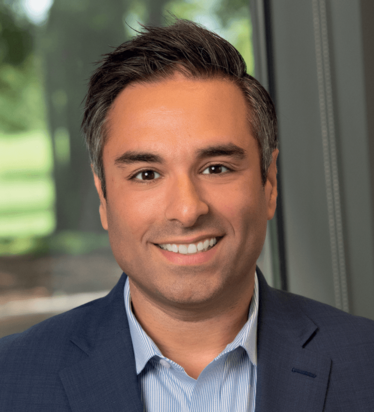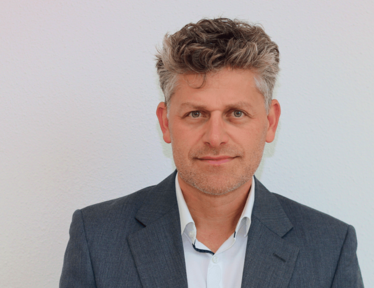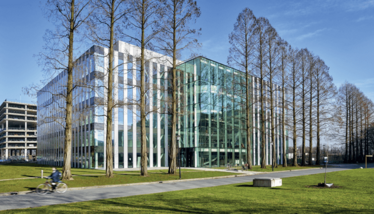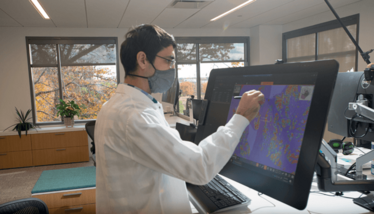The Antibody Saga – Key Milestones and Big Predictions
Will next gen antibodies knock our socks off? Experts consider the future of Ab-based drug development
| 8 min read
sponsored by Bio-Rad Laboratories

Mark Fereshteh, phd
Headquartered in Copenhagen, Denmark, international biotech company Genmab is passionate about using “knock-your-socks-off” (KYSO) antibodies to turn science into medicine for cancer and other serious diseases. We spoke with two experts from the company – David Satijn, PhD, and Mark Fereshteh, PhD – for their takes on the key milestones and trends in antibody drug development.
As Senior Vice President, Head of Discovery, Satijn’s role is to develop the company’s strategy while supervising tools and materials, technologies, antibody generation, and new antibody formats and products. He previously worked as an assistant professor studying the role of epigenetic elements and the stable production of recombinant antibodies. In his view, there are several good reasons why antibodies have become such a powerful therapeutic force.
“The use of antibody therapeutics is well established; their ability to target specific molecules and cells in the body makes them highly effective as treatments,” he says. “Antibodies have a long half-life in the body that allows them to provide sustained therapy over a long period of time. They also benefit from a good safety profile, with relatively few side effects – compare this to something like traditional chemotherapy, and it’s obvious why cancer is such an important area of therapeutic antibody development.”
Satijn cites five major milestones in antibody discovery:
- Discovery of antibodies. In the late 19th century, researchers discovered that serum from animals that had recovered from a disease could be used to protect other animals from the same disease.
- Monoclonal antibody (mAb) technology. In 1975, Georges Köhler and César Milstein developed a technique to produce mAbs, revolutionizing antibody production and paving the way for the development of therapeutic antibodies.
- Approval of the first therapeutic antibody. In 1986, the first therapeutic antibody, muromonab-CD3, was approved by the FDA to prevent organ rejection in transplant patients.
- Development of chimeric and humanized antibodies. In the 1990s, researchers developed chimeric and humanized antibodies, which made it possible to use antibodies derived from non-human sources in humans without causing an immune reaction.
- Approval of first fully human antibody. In 2002, adalimumab was approved by the FDA for treating rheumatoid arthritis.
Fereshteh currently serves as Genmab’s Vice President, Global Head of Precision Medicine, which includes the pathology, translational medicine, precision medicine operations, clinical genomics, and clinical biomarkers teams. For him, one of the biggest trends in antibody drug development right now is bispecifics. “Bispecific antibody therapeutics have made great strides in recent years,” he explains, “and offer significant promise in how we treat cancer and other serious diseases. Bispecific antibodies bind to two different targets on two different cells at the same time, unlike monoclonal antibody therapies that latch on to a single antigen on a single cell. Seven bispecific antibody medicines have been approved to date, two of which utilize Genmab’s bispecific technology.”

David Satijn, phd
Headquartered in Copenhagen, Denmark, international biotech company Genmab is passionate about using “knock-your-socks-off” (KYSO) antibodies to turn science into medicine for cancer and other serious diseases. We spoke with two experts from the company – David Satijn, PhD, and Mark Fereshteh, PhD – for their takes on the key milestones and trends in antibody drug development.
As Senior Vice President, Head of Discovery, Satijn’s role is to develop the company’s strategy while supervising tools and materials, technologies, antibody generation, and new antibody formats and products. He previously worked as an assistant professor studying the role of epigenetic elements and the stable production of recombinant antibodies. In his view, there are several good reasons why antibodies have become such a powerful therapeutic force.
“The use of antibody therapeutics is well established; their ability to target specific molecules and cells in the body makes them highly effective as treatments,” he says. “Antibodies have a long half-life in the body that allows them to provide sustained therapy over a long period of time. They also benefit from a good safety profile, with relatively few side effects – compare this to something like traditional chemotherapy, and it’s obvious why cancer is such an important area of therapeutic antibody development.”
Satijn cites five major milestones in antibody discovery:
- Discovery of antibodies. In the late 19th century, researchers discovered that serum from animals that had recovered from a disease could be used to protect other animals from the same disease.
- Monoclonal antibody (mAb) technology. In 1975, Georges Köhler and César Milstein developed a technique to produce mAbs, revolutionizing antibody production and paving the way for the development of therapeutic antibodies.
- Approval of the first therapeutic antibody. In 1986, the first therapeutic antibody, muromonab-CD3, was approved by the FDA to prevent organ rejection in transplant patients.
- Development of chimeric and humanized antibodies. In the 1990s, researchers developed chimeric and humanized antibodies, which made it possible to use antibodies derived from non-human sources in humans without causing an immune reaction.
- Approval of first fully human antibody. In 2002, adalimumab was approved by the FDA for treating rheumatoid arthritis.
Fereshteh currently serves as Genmab’s Vice President, Global Head of Precision Medicine, which includes the pathology, translational medicine, precision medicine operations, clinical genomics, and clinical biomarkers teams. For him, one of the biggest trends in antibody drug development right now is bispecifics. “Bispecific antibody therapeutics have made great strides in recent years,” he explains, “and offer significant promise in how we treat cancer and other serious diseases. Bispecific antibodies bind to two different targets on two different cells at the same time, unlike monoclonal antibody therapies that latch on to a single antigen on a single cell. Seven bispecific antibody medicines have been approved to date, two of which utilize Genmab’s bispecific technology.”

Genmab Headquarters in Copenhagen, Denmark
But what lies ahead?
What are the most exciting areas for future development in the antibody space? Genmab’s experts have four predictions:
1. Expansion of antibody-based therapeutics beyond traditional diseases. Antibodies have been used primarily to treat cancer, autoimmune diseases, and infectious diseases. However, there is growing interest in using antibodies to treat other diseases, such as neurodegenerative diseases, metabolic diseases, and cardiovascular diseases. We could see a shift in focus of antibody discovery to less studied targets such as those involved in rare diseases or those that have been difficult to target with traditional small molecule drugs.
2. Greater use of multi-specific antibodies. Multi-specific antibodies are designed to target multiple targets simultaneously, and may offer greater efficacy and fewer side effects compared with single-target antibodies. As technologies for designing and producing multi-specific antibodies improve, they may become more common in the clinic.
3. Improve high-throughput screening technologies, including phage display and yeast display. New screening methods should consider greater speed, efficiency, and accuracy.
4. More use of AI and machine learning algorithms. These technologies are already being used to analyze large datasets and predict which antibody candidates are most likely to be effective, but as these technologies continue to improve, they may become even more integrated into the antibody discovery process.
According to Satijn, “Advances in antibody research and discovery have had a significant impact on the lives of patients with cancer and other serious diseases. However, we are only at the tip of the iceberg of what we can achieve. Currently, there are many new antibody product formats that hold the key to unlocking new approaches to tackle cancer and other serious diseases.”
Fereshteh also stresses the importance of precision medicine in the therapies of the future – as well as the need to keep the focus on patients. “One of the most powerful tools in the innovation arsenal is the patient voice, and we must continue to listen to them throughout the development process from discovery to commercialization to ensure their needs are informing how treatments are optimized,” he says. “It’s important for the industry to continue to gather insights from patients to inform the development of new treatment options, and to better understand which patients are likely to benefit from specific types of treatments. Integrating insights about patients, diseases, therapies, and antibody modalities will continue to be fundamental to our scientific, clinical, and treatment strategies.”
For more information visit www.genmab.com & www.oxfordbiotherapeutics.com

New screening methods should consider greater speed, efficiency, and accuracy
The ABCs of ADC Potential
Therapeutic antibodies are by no means a new thing, but they continue to generate exciting new modalities, as well as a growing market share. According to a Coherent Markets Insights Report, the field is expected to be worth a potential $534.26 billion by 2030. Seeing the potential in antibody therapeutics, Christian Rohlff founded clinical stage biotech company Oxford Biotherapeutics in 2004 to develop immune therapies. Before then, he worked with the US National Cancer Institute and Oxford Glycosciences, where he led oncology partnerships with Pfizer, GSK, Bayer, Wyeth, Takeda, Oxford University, and the FDA.
For Rohlff, ADCs are one of the most exciting modalities of antibody therapeutics. Here, he tells us why.
What areas of antibody drug discovery and development excite you the most?
When it comes to antibodies, I’m really excited about ADCs, which are becoming a mainstay of cancer therapy. The first generation of ADCs was discovered almost 20 years ago – to much excitement – but when the first checkpoint inhibitors were approved, attention shifted more towards those drugs. During the last three years, however, there has been a huge resurgence of interest with several new drugs coming to market, including Gilead’s Trodelvy (sacituzumab govitecan-hziy) and Daiichi Sankyo’s Enhertu (trastuzumab deruxtecan).
This interest has also been reflected in merger and acquisition activity, such as with Gilead and Immunomedics, Merck and VelosBio, and Boehringer Ingelheim and NBE-Therapeutics.
We’re now looking at a second generation of ADCs with improved efficacy and therapeutic index. Enhertu, for example, is considered a second-generation ADC because it can treat people who do not respond to the first generation of drugs – this is a major milestone in cancer therapeutics.
Another major trend is the convergence between ADCs and immunotherapies. As we understand more about immuno-suppressive cells in the tumor microenvironment, it may allow us to harness the dual targeting of cancer cells and immuno-suppressive cells to develop innovative treatments for cancer. ADCs could potentially be used to re-engage and reactivate a patient’s immune system, thereby “priming” a patient for immunotherapy. Bringing these therapies together could improve the treatment landscape for both kinds of medicines.
What therapeutic indications are popular targets?
Solid tumors are particularly exciting targets. Despite the tremendous enthusiasm surrounding CAR-T therapy, we are still waiting for these to be clinically applied in solid tumors. Meanwhile, two out of three solid tumor patients do not respond to checkpoint inhibitors, so there’s a big void to be filled for solid tumor treatment. It is possible that ADCs may be able to address this, making indications like lung cancer, ovarian cancer, and breast cancer prime targets for development.
Now that the industry is convinced about the potential of ADCs to complement immunotherapies, I’d like to see more partnerships between ADC and immuno-oncology companies.
How can time to market for ADCs be accelerated?
ADCs often target orphan indications where, if approved, they have the potential to become the only effective treatment for patients. Here, accelerated approval via orphan drug indication routes is possible, but developers need to work closely with regulators.
Traditionally, gaining regulatory approval for first-in-human studies is far more demanding with ADCs than with traditional biopharmaceuticals. At Oxford Biotherapeutics, we use two approaches to validate our drug candidates and increase their speed to market. First, we have carefully curated partnering strategies, with internationally renowned biotechnology leaders, to increase our chances of success. Second, we use a platform-based approach to our drug development. We focus on analyzing and externally validating the critical quality attributes of our molecules, constructing defined testing plans, and filing INDs relatively rapidly.
However, while speed to market is important, it goes without saying that this must never compromise careful validation of a drug’s safety and efficacy.
What developments would you like to see in the field in the coming years?
It would be great to see the ADC space leading the way in optimizing patient selection strategies. Now a mature technology, there’s great potential for the space to develop further in patient selection and companion diagnostics, which have the potential to help establish a much better dose-response relationship between antigen expression and efficacy compared with other therapeutic areas that are lagging behind.
Now that we have a greater understanding of how ADCs and immunotherapies can work together, we also need to start seeing development strategies that create synergy between these two treatments, as I mentioned earlier. I hope that in the next few years we’ll see more partnerships between ADC companies and immunotherapy companies leveraging this approach.



















